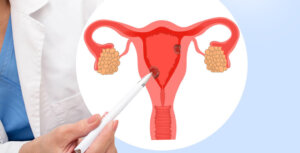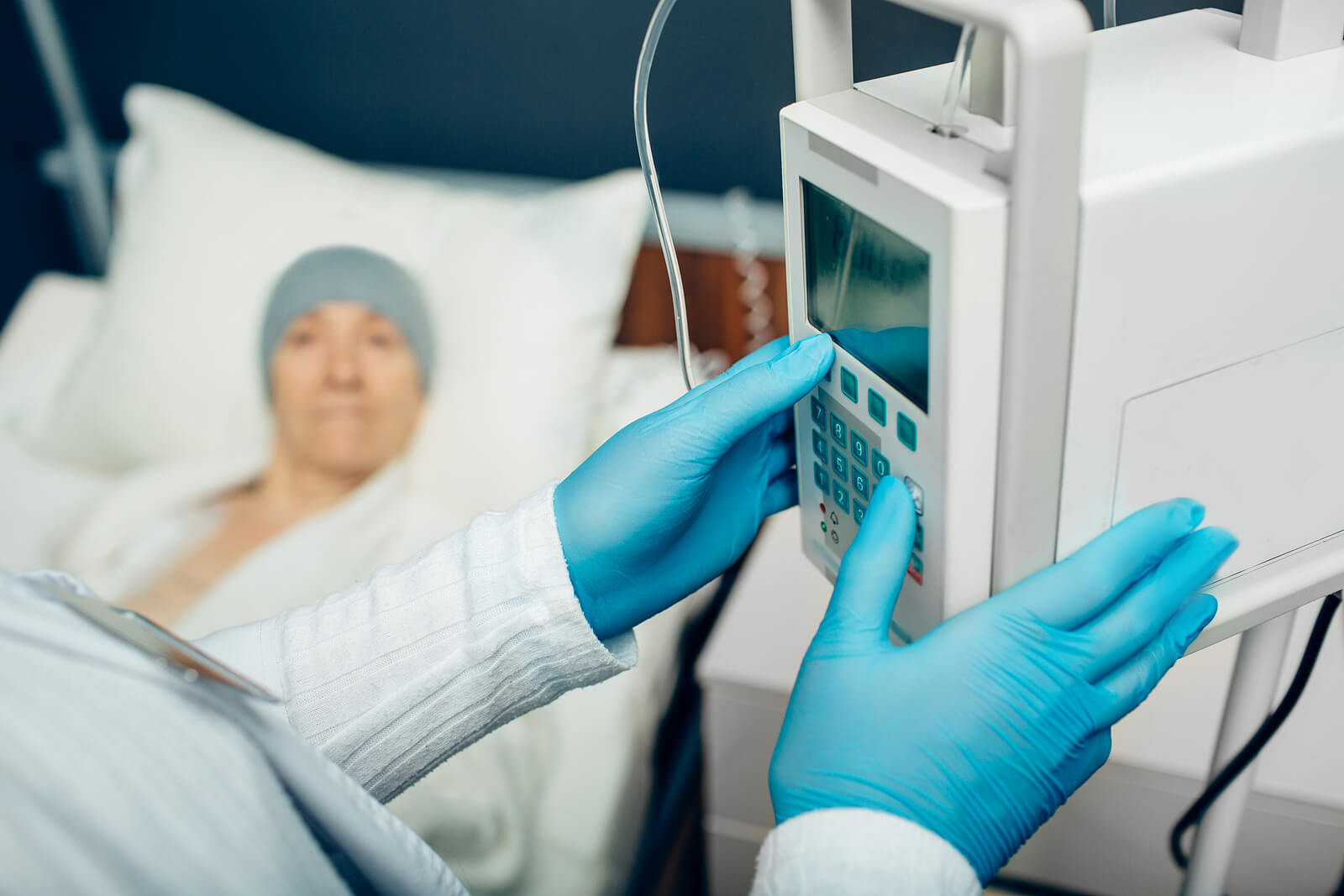Endometrial Cancer: Symptoms, Causes, and Treatment

According to the World Cancer Research Foundation, endometrial cancer is the sixth most common cancer in women. Its prevalence hasn’t stopped increasing in recent years. At present, and according to researchers, there are 9.57 cases per 100,000 women.
It’s also known as cancer of the uterus or cancer of the body of the uterus in order to differentiate it from cervical cancer. It occurs when cells in the endometrium (inner lining of the uterus) begin to grow out of control. Today, we’ll show you everything you should know about it.
Endometrial Cancer Symptoms

Endometrial cancer symptoms usually don’t occur in the early stages of cell division. It may take a couple of weeks or months before you notice a visible sign, although, unlike other types of cancer, these always develop. Based on The Royal Women’s Hospital, we invite you to be aware of the following:
- Persistent painful urination
- Pain or discomfort in the abdomen area
- Unusual bloody or brown vaginal discharge (often smelly)
- Unusually heavy periods
- Bleeding between periods
- Bleeding after menopause
The latter is the most characteristic symptom, as most cases occur after women have gone through menopause. As the Foundation for Women’s Cancer reminds us, all women in this stage should be aware of this sign.
Younger girls should pay attention to them too, especially about sudden changes in their menstrual cycle. Of course, these aren’t always indicators of endometrial cancer, but under no circumstances can you ignore them.
The main causes of endometrial cancer
As with all types of cancer, researchers aren’t quite sure what mechanisms are behind endometrial carcinoma. Of course, several risk factors have been established so far. According to the American Cancer Society, the most important are the following:
- Obesity: Studies and research continue to associate obesity with an increased risk of developing endometrial cancer. In turn, obese patients have greater complications and poorer prognoses during treatment.
- Hormonal changes: Especially those that take place for a long time. Pregnancy, taking birth control pills, and estrogen therapy after menopause are the best examples. Also, conditions that alter hormone levels, such as polycystic ovary syndrome.
- Family history: If you have direct relatives who’ve developed this condition or colorectal cancer, you’re more likely to suffer from it as well. This applies mainly to parents and siblings.
- History of past cancer: Especially ovarian and breast cancer. Even if you’ve successfully overcome one of these cancers, you’re more likely than a woman with no history to develop endometrial carcinoma.
- Age: Although we’ve already pointed out that young women can also present it, researchers agree that it’s much more frequent between 50 and 65 years of age.
- Diet and exercise: Evidence indicates that physical activity, even low intensity, is associated with a lower risk of developing this type of cancer (up to 35%). A diet high in fat and processed foods has the opposite effect.
Apart from this, the use of the intrauterine device, suffering from chronic diseases (such as type 2 diabetes), and having a history of endometrial hyperplasia are also associated as risk factors. If you’re part of any of these groups, it doesn’t mean that you’ll develop cancer, but it does mean that you have a greater chance in contrast to those who don’t.
Some of these factors you can’t change, while others depend on your lifestyle. If you modify your diet, exercise, and lose weight, you tip the balance in your favor. Keep this in mind, especially if you have a family history of cancer or suffer from a chronic disease.
Endometrial cancer treatment
Many cases of endometrial cancer are found during its first few weeks. Thanks to this, specialists can act faster, thus attacking cancer cells to prevent them from multiplying. Treatment depends on many factors. Johns Hopkins Medicine notes the following:
- Medical history and general health status
- Your preference or possibilities
- The size of the cancer and its extent (the stage of the cancer)
- The rate at which it’s growing (grade of cancer)
- The tissue from which it originated (type of cancer)
In this regard, 6 types of endometrial cancer can be identified (among the most common, at least), 3 degrees, and 4 stages or stages of evolution. All this will be discovered during the diagnostic process and will serve as the basis for choosing the best therapy indicated for your case. We’ll mention below the four most used options.
1. Surgery
Surgery is the main treatment for endometrial carcinoma. It consists of a hysterectomy (removal of the uterus), salpingectomy (removal of the fallopian tubes) and an oophorectomy (removal of the ovaries). Lymph nodes are also often removed to check for cancer expansion.
Depending on the context, the specialist may also wash the pelvic cavity, remove the omentum, and perform peritoneal biopsies. If malignant cells are found elsewhere, surgery will be done to remove them.
2. Radiation therapy
This can be done before surgery (to shrink the cancer), after (to remove traces of cells), or as main therapy (if the carcinoma is very small, usually). Radiation therapy consists of sessions between 4 to 6 weeks in which high-energy radiation is used. This is supplied through the following methods:
- Brachytherapy: Radioactive materials are placed around cancer cells.
- External beam radiation therapy: An external machine is used to direct the rays to the affected area.
The process is generally painless, although it does carry several side effects. The first are tiredness and an upset stomach. Then vomiting, nausea, and diarrhea appear. Irritation in the bladder, intestinal walls, rectal bleeding, and skin blisters are relatively common.
3. Chemotherapy

Chemotherapy is the administration of drugs to control or kill cancer. It’s used before or after surgery, but also as the main therapy. In the latter cases, it’s preferred when cancer has spread to other parts of the body and a more general action is required (stages III and IV).
Administration is done through the vein or orally with the intake of tablets. This is done in the form of cycles and is done on the basis of various medications. The most important side effects are hair loss, loss of appetite, mouth ulcers, vaginal ulcers, nausea, and vomiting.
4. Hormone therapy
This treatment is preferred to treat the last two stages of cancer or for recurrent episodes (that is, cancer that has come back after treatment). The application of certain hormones slows the growth and progression of the cancer. The most commonly used are progestins, tamoxifen, aromatase inhibitors, and luteinizing hormone-releasing hormone agonists.
Among its side effects, we highlight a sudden sensation of heat, weight gain, night sweats, vaginal dryness, and muscle aches. It’s a relatively novel therapy with open research fields on alternatives for use to make it more effective.
Other treatment options are immunotherapy and targeted therapy. The specialist will talk to you about them in case endometrial cancer is detected during diagnosis. We invite you to consult with one if you discover the pattern of symptoms listed at the beginning.
According to the World Cancer Research Foundation, endometrial cancer is the sixth most common cancer in women. Its prevalence hasn’t stopped increasing in recent years. At present, and according to researchers, there are 9.57 cases per 100,000 women.
It’s also known as cancer of the uterus or cancer of the body of the uterus in order to differentiate it from cervical cancer. It occurs when cells in the endometrium (inner lining of the uterus) begin to grow out of control. Today, we’ll show you everything you should know about it.
Endometrial Cancer Symptoms

Endometrial cancer symptoms usually don’t occur in the early stages of cell division. It may take a couple of weeks or months before you notice a visible sign, although, unlike other types of cancer, these always develop. Based on The Royal Women’s Hospital, we invite you to be aware of the following:
- Persistent painful urination
- Pain or discomfort in the abdomen area
- Unusual bloody or brown vaginal discharge (often smelly)
- Unusually heavy periods
- Bleeding between periods
- Bleeding after menopause
The latter is the most characteristic symptom, as most cases occur after women have gone through menopause. As the Foundation for Women’s Cancer reminds us, all women in this stage should be aware of this sign.
Younger girls should pay attention to them too, especially about sudden changes in their menstrual cycle. Of course, these aren’t always indicators of endometrial cancer, but under no circumstances can you ignore them.
The main causes of endometrial cancer
As with all types of cancer, researchers aren’t quite sure what mechanisms are behind endometrial carcinoma. Of course, several risk factors have been established so far. According to the American Cancer Society, the most important are the following:
- Obesity: Studies and research continue to associate obesity with an increased risk of developing endometrial cancer. In turn, obese patients have greater complications and poorer prognoses during treatment.
- Hormonal changes: Especially those that take place for a long time. Pregnancy, taking birth control pills, and estrogen therapy after menopause are the best examples. Also, conditions that alter hormone levels, such as polycystic ovary syndrome.
- Family history: If you have direct relatives who’ve developed this condition or colorectal cancer, you’re more likely to suffer from it as well. This applies mainly to parents and siblings.
- History of past cancer: Especially ovarian and breast cancer. Even if you’ve successfully overcome one of these cancers, you’re more likely than a woman with no history to develop endometrial carcinoma.
- Age: Although we’ve already pointed out that young women can also present it, researchers agree that it’s much more frequent between 50 and 65 years of age.
- Diet and exercise: Evidence indicates that physical activity, even low intensity, is associated with a lower risk of developing this type of cancer (up to 35%). A diet high in fat and processed foods has the opposite effect.
Apart from this, the use of the intrauterine device, suffering from chronic diseases (such as type 2 diabetes), and having a history of endometrial hyperplasia are also associated as risk factors. If you’re part of any of these groups, it doesn’t mean that you’ll develop cancer, but it does mean that you have a greater chance in contrast to those who don’t.
Some of these factors you can’t change, while others depend on your lifestyle. If you modify your diet, exercise, and lose weight, you tip the balance in your favor. Keep this in mind, especially if you have a family history of cancer or suffer from a chronic disease.
Endometrial cancer treatment
Many cases of endometrial cancer are found during its first few weeks. Thanks to this, specialists can act faster, thus attacking cancer cells to prevent them from multiplying. Treatment depends on many factors. Johns Hopkins Medicine notes the following:
- Medical history and general health status
- Your preference or possibilities
- The size of the cancer and its extent (the stage of the cancer)
- The rate at which it’s growing (grade of cancer)
- The tissue from which it originated (type of cancer)
In this regard, 6 types of endometrial cancer can be identified (among the most common, at least), 3 degrees, and 4 stages or stages of evolution. All this will be discovered during the diagnostic process and will serve as the basis for choosing the best therapy indicated for your case. We’ll mention below the four most used options.
1. Surgery
Surgery is the main treatment for endometrial carcinoma. It consists of a hysterectomy (removal of the uterus), salpingectomy (removal of the fallopian tubes) and an oophorectomy (removal of the ovaries). Lymph nodes are also often removed to check for cancer expansion.
Depending on the context, the specialist may also wash the pelvic cavity, remove the omentum, and perform peritoneal biopsies. If malignant cells are found elsewhere, surgery will be done to remove them.
2. Radiation therapy
This can be done before surgery (to shrink the cancer), after (to remove traces of cells), or as main therapy (if the carcinoma is very small, usually). Radiation therapy consists of sessions between 4 to 6 weeks in which high-energy radiation is used. This is supplied through the following methods:
- Brachytherapy: Radioactive materials are placed around cancer cells.
- External beam radiation therapy: An external machine is used to direct the rays to the affected area.
The process is generally painless, although it does carry several side effects. The first are tiredness and an upset stomach. Then vomiting, nausea, and diarrhea appear. Irritation in the bladder, intestinal walls, rectal bleeding, and skin blisters are relatively common.
3. Chemotherapy

Chemotherapy is the administration of drugs to control or kill cancer. It’s used before or after surgery, but also as the main therapy. In the latter cases, it’s preferred when cancer has spread to other parts of the body and a more general action is required (stages III and IV).
Administration is done through the vein or orally with the intake of tablets. This is done in the form of cycles and is done on the basis of various medications. The most important side effects are hair loss, loss of appetite, mouth ulcers, vaginal ulcers, nausea, and vomiting.
4. Hormone therapy
This treatment is preferred to treat the last two stages of cancer or for recurrent episodes (that is, cancer that has come back after treatment). The application of certain hormones slows the growth and progression of the cancer. The most commonly used are progestins, tamoxifen, aromatase inhibitors, and luteinizing hormone-releasing hormone agonists.
Among its side effects, we highlight a sudden sensation of heat, weight gain, night sweats, vaginal dryness, and muscle aches. It’s a relatively novel therapy with open research fields on alternatives for use to make it more effective.
Other treatment options are immunotherapy and targeted therapy. The specialist will talk to you about them in case endometrial cancer is detected during diagnosis. We invite you to consult with one if you discover the pattern of symptoms listed at the beginning.
- Fader AN, Arriba LN, Frasure HE, von Gruenigen VE. Endometrial cancer and obesity: epidemiology, biomarkers, prevention and survivorship. Gynecol Oncol. 2009 Jul;114(1):121-7.
- Matthews CE, Xu WH, Zheng W, Gao YT, Ruan ZX, Cheng JR, Xiang YB, Shu XO. Physical activity and risk of endometrial cancer: a report from the Shanghai endometrial cancer study. Cancer Epidemiol Biomarkers Prev. 2005 Apr;14(4):779-85.
- Morice, P., Leary, A., Creutzberg, C., Abu-Rustum, N., & Darai, E. Endometrial cancer. The Lancet. 2016; 387: 1094-1108.
- Schmandt RE, Iglesias DA, Co NN, Lu KH. Understanding obesity and endometrial cancer risk: opportunities for prevention. Am J Obstet Gynecol. 2011 Dec;205(6):518-25.
- Zhang S, Gong TT, Liu FH, Jiang YT, Sun H, Ma XX, Zhao YH, Wu QJ. Global, Regional, and National Burden of Endometrial Cancer, 1990-2017: Results From the Global Burden of Disease Study, 2017. Front Oncol. 2019 Dec 19;9:1440. d
Este texto se ofrece únicamente con propósitos informativos y no reemplaza la consulta con un profesional. Ante dudas, consulta a tu especialista.







